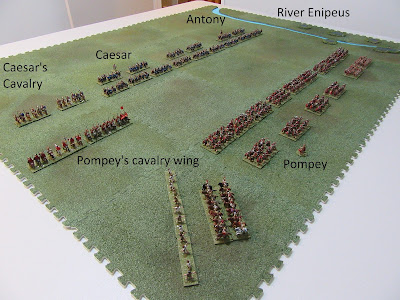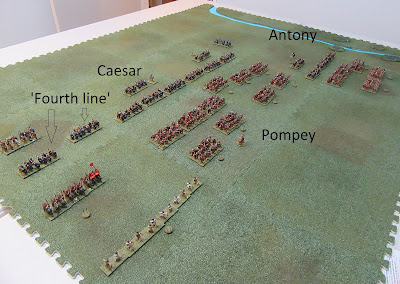The figure gaming drought was broken last weekend with a refight of Pharsalus using - you guessed it - Lost Battles. The family has gone back to Japan for a visit now that the borders have reopened somewhat so with the house to myself it has been a bit easier to use the hobby space (i.e., I can set up the computer on the dining room table rather than on one of the hobby ones!).
SP is still learning the rules, so I thought it was time to bring in a brilliant general so that he can see the affect of a 'flip-flop' on the tactics of the game. In a flip-flop, the brilliant general once per game can reverse the turn order, effectively allowing him to position himself for a more lethal attack, reinforce a zone, or else to exploit a breakthrough.
Pharsalus, when using the historical deployments, is a fairly straightforward affair in Lost Battles. The main choice is about when and how Caesar is to reinforce his right wing cavalry, and then it's about rolling dice and intervening with attack bonuses at appropriate times. Crucially, there is also the matter of when to employ 'favour of the gods' (essentially a re-roll for either an attack you've flunked or one that the enemy has prosecuted a little too vigorously for one's liking). With favour of the gods, once one side has used it, they cannot use it again until their opponent has. As you can imagine, it leads to some difficult decisions in-game and, during the post-mortems, moments for reflection when you consider the coulda, woulda, shouldas.
SP wanted to take up the cudgel for Pompey, so we started the action on turn two (turn one being taken up by the historical deployments).
As I'm sure most readers are aware, Pompey and the Optimates have numerical superiority in both horse and foot, and have concentrated the cavalry on the left under Caesar's old Gallic War lieutenant Labienus. To counter this cavalry supremacy, Caesar used a 'fourth line' - veteran legionaries supposedly re-armed with long spears and tasked with reinforcing the wing once the cavalry battle had commenced. To reflect Caesar's qualitative superiority, all his troop units are rated veteran, which gives them high morale, better manoeuvrability, and cheaper access to attack bonuses (i.e., +1s to attacks which are paid for with excess command points).
Pompey's army has a fighting value of 77, and Caesar's 92.
 |
| The battlefield at start. |
Pompey began with a powerful cavalry attack. He scored three hits across two attacks, spending one unit of Caesar's cavalry and shattering the other. Caesar elected not to use FotG to call for a re-roll. Elsewhere, Pompey advanced in his own zone and the centre, leaving his right refused.
Caesar employed the flip-flop immediately to reinforce the cavalry with the fourth line, and advanced Antony into contact on his left.
The serious fighting now commenced.
 |
| Mid battle, with the cavalry fight still undecided. |
Both sides experienced rising attrition in in the infantry fight. As units became spent they were recycled from the front line to avoid being shattered. Caesar eventually won the cavalry battle (but not without another fright or two) and got in behind the Pompeian line to reduce the enemy's morale. With both sides almost entirely spent and a corresponding reduced ability to recycle, units began to shatter.
It was at this time that Caesar's veterans came into their own. Utilising their superior manoeuvrability, Caesar was able to shuffle fresh units from one zone to another to increase the overall resilience of the line. Pompey, having no such capacity, began to lose units sooner.
It was his right that came under pressure first, as Antony pressed the attack remorselessly. Before long Pompey's own zone began to falter as well.
 |
| Final moments. |
At last the Pompeians, with eight units shattered and two zones surrounded, collapsed, but not before having inflicted significant damage on Caesar's own zone.
In the final accounting we found Caesar had inflicted 101 points of damage on the Pompeians and suffered 76 himself. When the handicap was added (double the difference in fighting value between the two armies), Pompey had scored a narrow game victory of 106 vs 101.
Caesar was left to rue a couple of moments - not using FotG to deflect the first charge of Labienus and his cavalry, and not attempting to rally a unit that shattered in his own zone being particular examples - but the result was a fair reflection of the battle. After that initial attack on the cavalry I always felt I needed to be doing more damage than I was managing to.
It was a close-fought, nerve-wracking fight, just as Pharsalus should be. SP played with his usual cool head and aversion to excessive risk-taking, both attributes serving him well in pulling off the game victory.
Round two, to decide the holder of the Washbourn Trophy, will be fought today with sides reversed.

Lovely looking game and a great advert for the rules. Top stuff.
ReplyDeleteAlways a good choice to quench that thirst! I'm hankering for a game also but the rebasing is holding things back! Great battle and visuals as ever Aaron.
ReplyDeleteThanks Tony. May be rebasing be as painless as possible!
DeleteCheers Aaron my latest Thureophoroi unit may be a bit of a breakthrough on making the process easier ... I just need to clear through my friends heroquest stuff 😑
DeleteReally please to see that there are other gamers who see the strengths and merits of LB’s
ReplyDeleteThank you - yes, I've been playing it since it came out, and it's still my favourite system for ancients. Glad to hear that you are a fan as well!
DeleteGreat write up. Thanks.
ReplyDeleteThanks Stan, much appreciated.
DeleteSounds like a great game Aaron, looks great too!
ReplyDeleteCheers Mike!
Delete